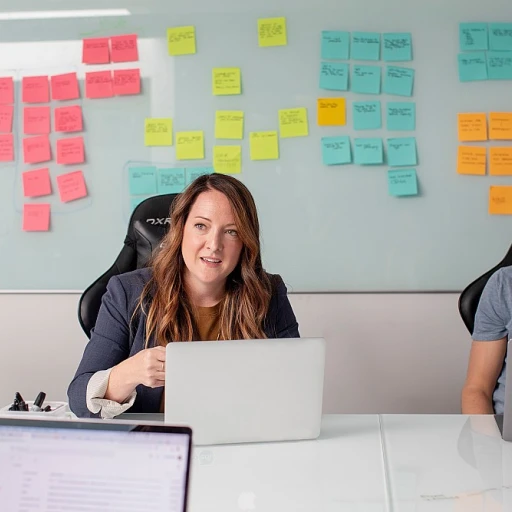
Understanding the Importance of Documentation in Continuous Learning
Role of Documentation in Sustaining Learning Initiatives
In the ever-evolving landscape of continuous learning, documentation stands as a pivotal pillar that supports and sustains learning initiatives. When effectively managed, documentation not only preserves critical knowledge but also fosters consistent growth and development within organizations. It serves as a framework for both policy and procedures, ensuring that learning objectives align with broader business goals and quality management standards.
From medicare to project management, documentation acts as a communication bridge, facilitating the exchange of ideas and knowledge among team members. By archiving project documentation, team efforts are streamlined, promoting efficiency and risk management across various sectors. High-quality documents increase transparency, allowing for enhanced support during project life cycles.
Adhering to documentation standards is crucial for successful outcomes. Standardized documents ensure that all team members can access and utilize the same resources, minimizing misunderstandings and facilitating smoother project transitions. This approach is particularly valuable in specialized fields such as health care, where accurate medical record keeping is vital for both compliance and quality patient care.
Central to any documentation policy is comprehending how these practices can lead to enhanced learning outcomes. The process of maintaining effective documentation requires effort and strategic placement, which often involves overcoming several challenges. By implementing best practices, organizations can elevate their learning capabilities, as highlighted in an article on skills enhancement through cognitive training techniques.
Key Elements of a Successful Documentation Policy
Fundamental Components of a Comprehensive Policy
To craft an effective documentation policy, understanding its core elements is essential. Developing a comprehensive policy involves integrating several key components that address the needs of diverse team members, the specific requirements of the project, and the overarching goals of effective communication and management.
Clear Objectives and Scope
The foundation of a successful documentation policy starts with clearly defined objectives and scope. This involves outlining the purpose of the documentation, which may include supporting project management, enhancing communication, adhering to standards, or complying with regulatory requirements like those in health care or medicare sectors. Defining the scope helps in setting boundaries and expectations for what the documentation will cover, whether it's business processes, procedure documentation, or project documentation.
Standardized Procedures and Formats
It is crucial to establish standardized procedures and formats for the creation, storage, and retrieval of documents. This standardization not only ensures consistency and quality across all documents but also facilitates easier management and accessibility. Utilizing templates and predefined formats can reduce the time spent by team members in document preparation and improve overall efficiency. Consider including guidelines for language and formatting to promote clarity and uniformity.
Robust Version Control and Access Management
Implementing a robust version control system is vital to maintain the integrity of documents. This involves tracking changes, ensuring the latest updates are easily accessible, and managing the access privileges of different team members. Effective version control prevents the duplication or loss of critical documents, ultimately supporting better document management and risk management processes.
Continuous Review and Updating Process
A dynamic documentation policy incorporates regular review and updating processes to keep the documents relevant and accurate. This continuous cycle of revisiting and refining policies procedures ensures the documentation evolves in alignment with any changes in project scope, business needs, or regulatory standards. This proactive approach to quality management contributes not just to maintaining compliance but also to enhancing the overall effectiveness of the policy.
Creating a successful documentation policy involves more than just drafting a few documents; it demands a strategic approach that aligns with mastering continuous improvement skills and accommodating the multifaceted aspects of business and project requirements.
Challenges in Implementing Documentation Policies
Navigating the Obstacles of Documentation Policies: A Diagnostic Overview
In a journey toward effective continuous learning, implementing documentation policies often presents distinct challenges. These hurdles can impede the smooth integration of documentation within the learning framework and, if not meticulously addressed, can compromise the efforts of diverse teams across any organization. One notable challenge is the resistance to change. Many team members may be comfortable with existing systems and processes, which makes the adoption of new documentation practices difficult. This reluctance isn't simply about adapting to new language or policies but can also reflect underlying concerns about workload and changes in communication approaches. Moreover, maintaining consistency in documentation standards can be demanding. Large organizations or those operating in sectors such as healthcare, where documentation like medical records is crucial, face difficulties ensuring that policy procedure adheres to set standards across all departments. Compounded by varying documentation standards for different projects, aligning these to fit company-wide practices and documentation policies is an impressive feat often wrestled with by management. Limited resources, both human and technological, also exacerbate these challenges. It can be overwhelming for project managers to ensure team members have the necessary support. Whether it is the skills needed for a new documentation policy or access to advanced documentation tools such as PDF management solutions, resource scarcity can cause significant bottlenecks in the process. Furthermore, the lack of a risk management approach in emerging documentation procedures can lead to the accumulation of inaccuracies in project documentation. Regular audits and the establishment of quality management and document review systems become essential components in circumventing potential pitfalls, ensuring that the documentation contributes effectively to continuous learning. To delve further into smart strategies and effective project management within industries that demand rigorous documentation practices, explore effective strategies for thought leadership in the coaching industry. As the journey of enhancing documentation continues, overcoming these challenges requires dedication and strategic insight, pivotal for elevating documentation as a cornerstone of continuous learning.Best Practices for Maintaining Effective Documentation
Strategies for Sustaining High-Quality Documentation
Effective documentation is a critical component in continuous learning projects and business operations. To maintain high standards and support team members efficiently, it’s crucial to adopt best practices. Here are a few strategies:- Establish Clear Documentation Standards: Create documentation standards that align with the organization’s objectives. This includes specifying formats, language, and documentation policies that ensure consistency and clarity across all documents. Implementing these standards can lead to more precise communication and better-informed decisions.
- Regularly Review and Update: Whether it’s a project policy or health care documentation, frequent review and updates are essential. Procedures and policies must reflect the current state of affairs and adhere to industry regulations such as those in Medicare services. Establish a schedule for periodic document reviews to ensure no outdated information persists in procedure documentation.
- Engage the Team: Documentation should be a collaborative effort involving project managers and team members. Their insights and feedback are vital to creating comprehensive and practical documents. Encourage a culture where team members advocate for continuous improvement in documentation processes and management policies.
- Implement Systematic Processes: An organizational routine that automates certain aspects of documentation can improve efficiency. Leverage software tools that streamline the documentation process and integrate it into the documentation policy management framework. This helps ensure consistency and accuracy while reducing manual errors.
- Provide Ongoing Training: Educate staff on best practices for documentation and project standards. Offer resources such as PDFs and articles that explain the significance of meticulous documentation to support ongoing skill development and compliance with policies procedures.
- Monitor and Measure: Establish metrics to assess the quality and effectiveness of documentation practices. This helps identify areas for improvement in communication and support within the team. Regular reports and feedback mechanisms should be part of this quality management approach.
Leveraging Technology to Enhance Documentation
Utilizing Technological Advancements for Better Documentation Practices
In the ever-evolving landscape of continuous learning, leveraging technology has become indispensable for effective documentation management. As teams and projects grow in size and complexity, the need for efficient documentation tools and platforms becomes more crucial. One of the primary benefits of technology in documentation is the ease of access it provides. Digital documents, unlike their traditional paper counterparts, can be accessed from anywhere at any time. This is particularly beneficial in the realm of continuous learning, where access to up-to-date information can significantly impact learning outcomes and project progression. Robust project management software often comes equipped with features that support documentation policies. These platforms not only help organize and manage documents but also integrate with communication tools to ensure that all team members are aligned with the project's objectives. By equipping teams with reliable tools, businesses can maintain their documentation policies procedures more effectively, minimizing the risk of duplication or loss of essential information. Another technological boon is the ability to ensure compliance with documentation standards. Automated processes can help project managers track changes, ensure adherence to standards best practices, and generate detailed reports. This not only improves transparency and accountability but also support risk management by identifying potential documentation gaps proactively. Furthermore, advancements in artificial intelligence and machine learning offer opportunities to enhance documentation processes. AI-driven tools can swiftly analyze large volumes of project documentation, identify errors or inconsistencies, and even suggest improvements based on standard procedures and policies. Finally, the shift toward electronic health records in healthcare highlights how technology can revolutionize documentation. Medical records once confined to dusty folders are now living digital documents that can be swiftly updated and securely shared across platforms, meeting both medicare and quality management standards. In conclusion, embracing technology in documentation management is not merely a trend but a necessity for businesses looking to uphold high standards in their continuous learning initiatives. By integrating technology, organizations can better manage their documents, foster effective communication, and ultimately, enhance the learning experience for their team members.Measuring the Impact of Documentation on Learning Outcomes
Evaluating Documentation's Influence on Learning Outcomes
Measuring the effectiveness of documentation in continuous learning involves several facets that contribute to a comprehensive assessment. A strategic approach is not only beneficial but essential in ensuring that learning objectives are met efficiently. To start, documentation should align with established documentation standards and policies procedures. This alignment ensures that every document adheres to quality management guidelines and supports the overall learning ecosystem. Evaluating the impact of documentation includes:- Analyzing Feedback: Gathering insights from team members and learners is crucial. Feedback helps identify areas where the documentation supports or hinders the learning process. Surveys, focus groups, and interviews can uncover valuable perspectives.
- Tracking Utilization: Metrics such as how often and by whom documents are accessed can highlight their relevance and utility. This process requires a robust policy procedure in place to regularly assess document usage.
- Assessing Learning Outcomes: Quantifying the achievement of learning goals can be indicative of the documentation's effectiveness. Correlating success rates with the presence or absence of thorough documentation provides actionable insights.
- Documentation Standards Compliance: Regular audits and reviews ensure that the documentation adheres to set standards, offering a benchmark for quality and consistency. This audit process also supports risk management by identifying potential gaps.
- Integration with Technology: Leveraging technology in project management, such as document management systems and PDF tools, can streamline the documentation process and enhance accessibility. Technology also aids in creating detailed reports that summarize the impact of documentation in clear, actionable terms.












